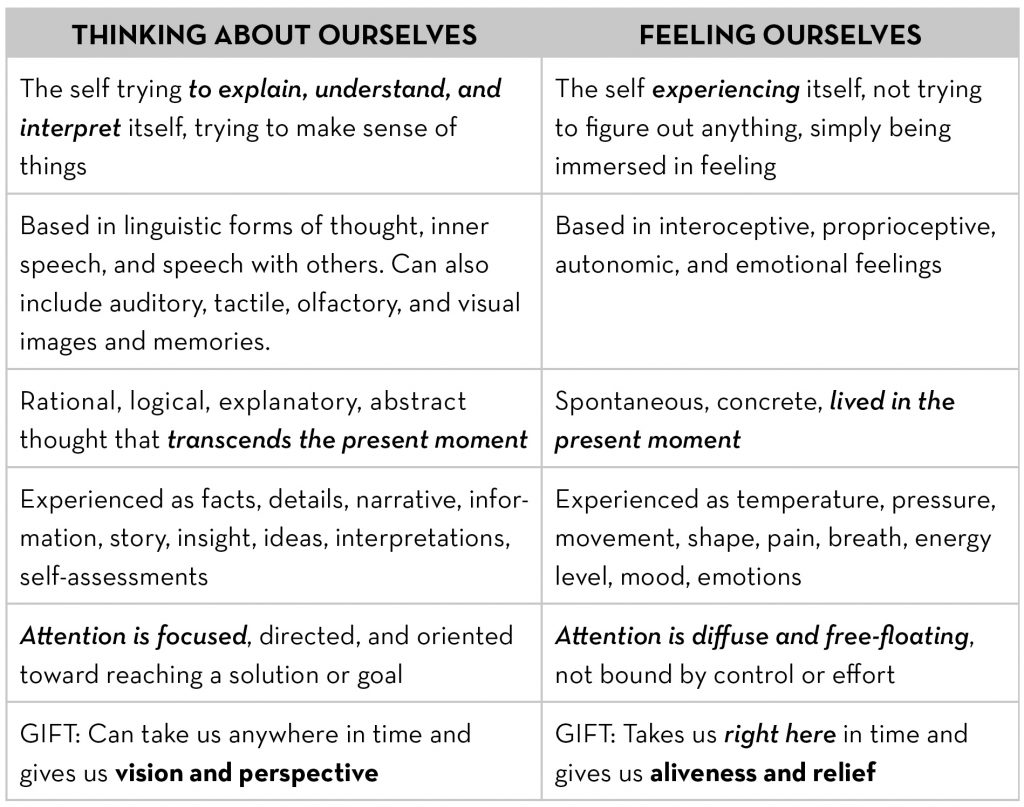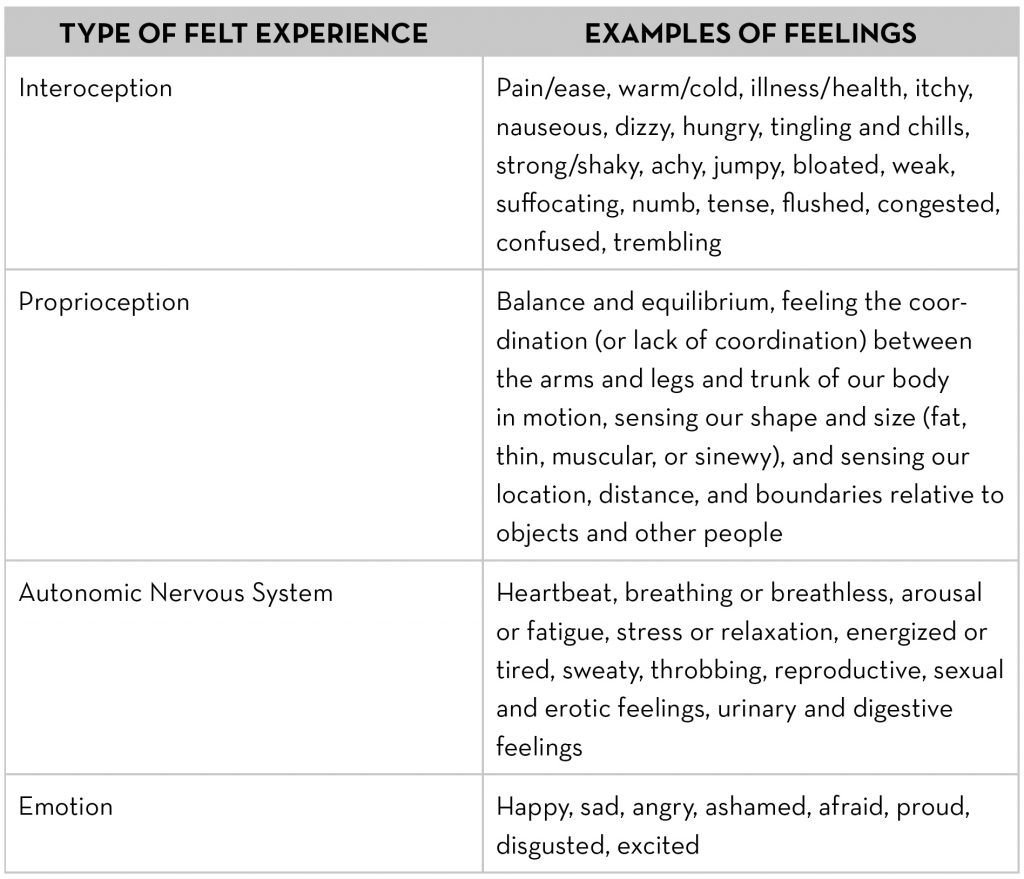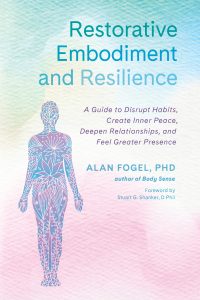Embodied Thinking and Embodied Feeling
Embodied self-awareness is both how we feel and experience ourselves and how we think about ourselves. Our only access to the experience of our whole body system is via these two forms of awareness. There is no other way to be embodied. There is no other way to be human.
Feeling and thinking can take many different forms, from the sublime to the ordinary, from love to hate, from passion to detachment. Understanding these different forms of embodied self-awareness (ESA)—their content and origins—and the many ways to monitor and regulate our ESA is the subject of my book.
Feeling and thinking, because they arise in different neural networks and have different pathways around the body, are for the most part mutually exclusive. We can’t do both at exactly the same time.* Whenever thoughts come into our awareness—even thoughts about our felt experience, such as “I wonder what caused this pain” or “I just need to slow down and focus on what I am feeling”—we immediately go off-line from our felt experience.
Table 1.1: Differences between the thinking and feeling components of embodied self-awareness†

Another shared Western cultural practice is that we learn, through formal systems of education, to think and that we are predisposed to think almost all the time. Since we are entirely familiar and practiced in thinking, let’s review what it means to feel something coming from inside the body. These self-feelings, or felt experiences, of ESA are composed of interoceptive, proprioceptive, autonomic, and emotional feelings. These components of felt experience will be covered in more detail in the next chapter, along with a discussion of where they arise in the nervous system. For now, Table 1.2 gives a brief overview.
Table 1.2: Felt experiences that arise from within our bodies

Curiously, interoception can also involve feelings about thoughts. There is the feeling when we know something but can’t quite recall it at the moment, a “tip of the tongue” feeling. Then there is the feeling that something we hear or see feels familiar, like we have been exposed previously but again can’t quite bring the prior situation into memory. A third feeling about thinking is the sense that we are getting close to solving a problem, the sense of coming to a conclusion, or a sense of completion. Finally, there is the sense of boredom, of having heard these thoughts or participated in these conversations, and continued exposure to these thoughts feels tedious or tiring.
Experiential Exercise: Thinking vs. Felt Experience
All the feelings listed in Table 1.2 are familiar. Everyone has felt them at some time but most likely for brief periods. It is so easy to think that we are living fully in the present moment with our felt experience, yet the fact is that we are thinking and not really feeling.
You can experience this attraction to thinking by taking a few minutes right now. First, think about how you feel and have been feeling today and the past few days. You’ll find it is fairly easy to generate a sizable list of self-descriptions that are likely to be fairly accurate. You probably will find it challenging to stop thinking so much, but let’s try and see what happens.
Instead of trying to think about yourself, sit or lie down in a comfortable place, and remove any distractions that might disturb you. This works best if you are in a quiet place. Close your eyes. See if you can slow your thoughts long enough to feel something concrete right in the present moment. It doesn’t really matter what you feel, so long as it captures your attention long enough for you to feel it. It could be the hardness or softness of the surface on which you are lying or sitting, the texture of your clothing against your skin, an ache or pain, an itch, your heartbeat, or an emotion that wants to surface.
The initial training in many embodied awareness practices such as mindfulness meditation begins with focusing on some concrete feeling, like your breath going in and out or your feet on the floor. Research done at various universities and medical centers in Norway shows that focused attention is not very helpful for accessing felt experience, which needs a more free-floating or diffuse kind of attention to the body. Focusing attention will activate an effort to concentrate and control, and it most typically leads into some kind of thinking about whether or not we are doing it right or getting where we think we are supposed to be going with this experiential exercise.
Instead, see if you can allow your attention to yourself to wander about your body. Let the wandering be without any deliberate effort to take a particular route through your body. Body scan meditations, for example, use focused attention, usually starting at the head and working the attention gradually down to the feet, or vice versa. That’s not what we want to do here. See if you can resist having a plan or purpose and just let your attention go wherever it finds something to feel, wherever your curiosity takes you.
Maybe there is a feeling of tightness or achiness in your chest. Notice that, and then broaden your attention to see if any other places feel tight like in your face or your belly. Again, you are sensing and feeling without any plan—you are following where your attention “wants” to go. See if there are any emotional feelings such as fear or worry or irritation that go with the tightness, or ache, or pain, or expansiveness, or whatever you feel.
See what thoughts come to you about any of these feelings, and just let them float around in your awareness as you keep coming back to your felt experiences. See if it is possible to do this without any deliberate effort to make the feeling get better, to change it, or to try to understand it. If you feel this urge to fix or change or explain your feeling, just notice that, and let the urge be merely another feeling that is coming up for you. It is not necessary to act on that urge.
Each time you come back to your felt experience, it may “land” in a different part of your body, so just practice letting yourself go wherever that takes you. At some point, if you give yourself enough time, as you are letting your attention wander through the sensations coming from your body, there is likely going to be one or a few sensations or emotions that begin to stand out, that capture your attention and hold it in one place for a least a few minutes. Once again, this attentional capture is not deliberate, not focused. It is someplace you arrive but not because you followed a specific route or plan.
Letting your attention drift around and then get drawn or pulled into a particular feeling endows that feeling with a personal intrinsic motivation to explore it. You don’t have to try to focus on it because you are just allowing the feeling to “call” you to it.
How is this calling different from focusing? Being “called” by a felt experience is similar to when you might be busy with something and a friend, child, or partner calls out to you and asks for your attention to something that they need to share with you. If you choose to drop your focus on your goals, plans, and expectations, you can be more open to the other person. You can just listen and take in the other person, what they say to you, and the feelings they express.
A lot of people have trouble just dropping their focus and really listening to themselves or to another person who calls them. If this happens to you, simply notice the pull of the focus, the wanting to not let go of whatever it was that you were working on. See if you can let that be just another feeling to which there is no attachment: it can float by as you let yourself be called by a different feeling or another person.
 In this experiential exercise, you are approaching your own body with a similar kind of openness that you might offer to another person, a similar dropping of your plans and expectations, a similar “showing up” in the present moment. You are “listening” to your own body “speaking” to you in its own way, and not because you are supposed to be doing something in particular or trying to control the outcome.
In this experiential exercise, you are approaching your own body with a similar kind of openness that you might offer to another person, a similar dropping of your plans and expectations, a similar “showing up” in the present moment. You are “listening” to your own body “speaking” to you in its own way, and not because you are supposed to be doing something in particular or trying to control the outcome.
Often this felt experience that captures your attention will get more intense and alive, and you will feel totally one with the experience. And at some point this feeling will begin to fade or soften, and you’ll eventually return to your thoughts. But see if you notice any change in yourself after staying with the feeling, like a deeper breath or a sense of relief. Feelings of relief and relaxation are some of the physiological signals indicating that you have allowed yourself to be fully in the present moment with a felt experience.
From Restorative Embodiment and Resilience: A Guide to Disrupt Habits, Create Inner Peace, Deepen Relationships, and Feel Greater Presence by Alan Fogel, published by North Atlantic Books, copyright © 2021. Reprinted by permission of publisher.
* I realize this statement is taking a rather extreme position. Some people I have talked to claim that they can do both at the same time. I have not had this experience, and the neural architecture doesn’t support this claim. If you feel you can do this, however, then I recommend slowing yourself down and really experimenting with seeing what you can feel when you are thinking. When I am feeling anything in my body, my sense is that the thoughts I was just previously having are somehow still “there” but transparent, faded into a background as residual images, and are no longer thoughts that I can “work on” or that lead anywhere.
To rephrase the earlier statement—that thinking and feeling can’t happen at the same time—almost any kind of thinking is a symptom of an impairment in the ability to sense our felt experience. Table 1.1 gives a summary of the differences between thinking about ourselves and feeling ourselves.
† I am grateful to Amanda Blake for allowing me to borrow some of her wording to construct this table. See Amanda Blake, Your Body Is Your Brain (Trokay Press, 2018).






